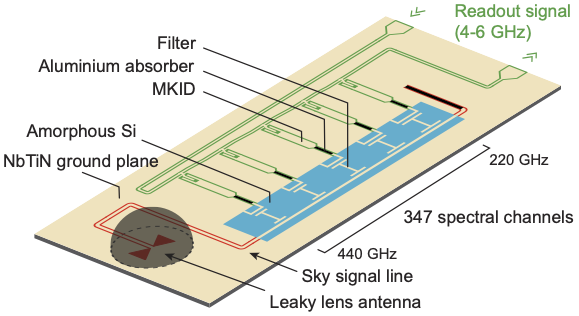ED2-1-INV
DESHIMA: Integrated superconducting spectrometer for ultra-wideband millimeter/submillimeter wave astronomy
Dec.1 17:55-18:20 (Tokyo Time)
Delft University of Technology1
SRON Netherlands Institute of Space Research2
Nagoya University3
National Astronomical Observatory of Japan4
The University of Tokyo5
Leiden University6
The integrated superconducting spectrometer (ISS) enables ultra-wideband, large field-of-view integral-field-spectrometer designs for mm-submm wave astronomy. DESHIMA (Deep Spectroscopic High-redshift Mapper) is a single-pixel ISS spectrometer for the ASTE 10-m telescope, designed to observe the 220-440 GHz band in a single shot, corresponding to a [CII] redshift range of z=3.3-7.6.
We present the first on-sky results of DESHIMA, obtained from October to December 2017 on the ASTE telescope. On the ISS chip of DESHIMA, the signal is captured by a lens-antenna and subsequently travels through a coplanar waveguide made of superconducting NbTiN, from which NbTiN bandpass filters branch out to divide the signal into separate frequency channels. At the output of each filter is a NbTiN/Al hybrid microwave kinetic inductance detector (MKID). The first generation of DESHIMA (DESHIMA 1.0) is a 1-pixel spectrometer that covers the 332-377 GHz band with 49 spectral channels, offering a spectral resolution F/dF ~ 380. We present detection of molecular emission lines from various sources, including a weakly redshifted CO line from the luminous infrared galaxy VV 114. The on-sky performance shows excellent agreement between the design and laboratory measurement in terms of the sensitivity, optical efficiency and beam pattern. In addition, we present wideband spectral maps of extended sources to demonstrate the potential of the ISS technology towards spectroscopic direct imaging.
Ongoing upgrades towards the octave-bandwidth full system (DESHIMA 2.0) include the development of a filterbank chip with ~350 channels and higher optical efficiency, a wideband quasioptical design, and observing methods for efficiently removing the atmosphere.
References: http://deshima.ewi.tudelft.nl/
Fig. 1 | Conceptual drawing of the integrated superconducting spectrometer chip of DESHIMA.
Keywords: Microwave Kinetic Inductance Detectors, Astronomical Instrumentation, Submillimeter wave, Spectroscopy
